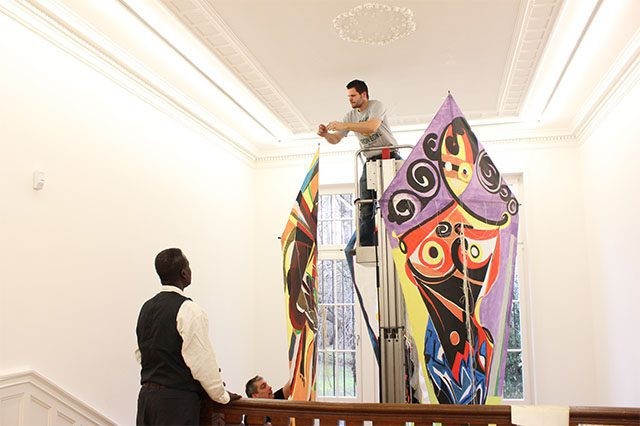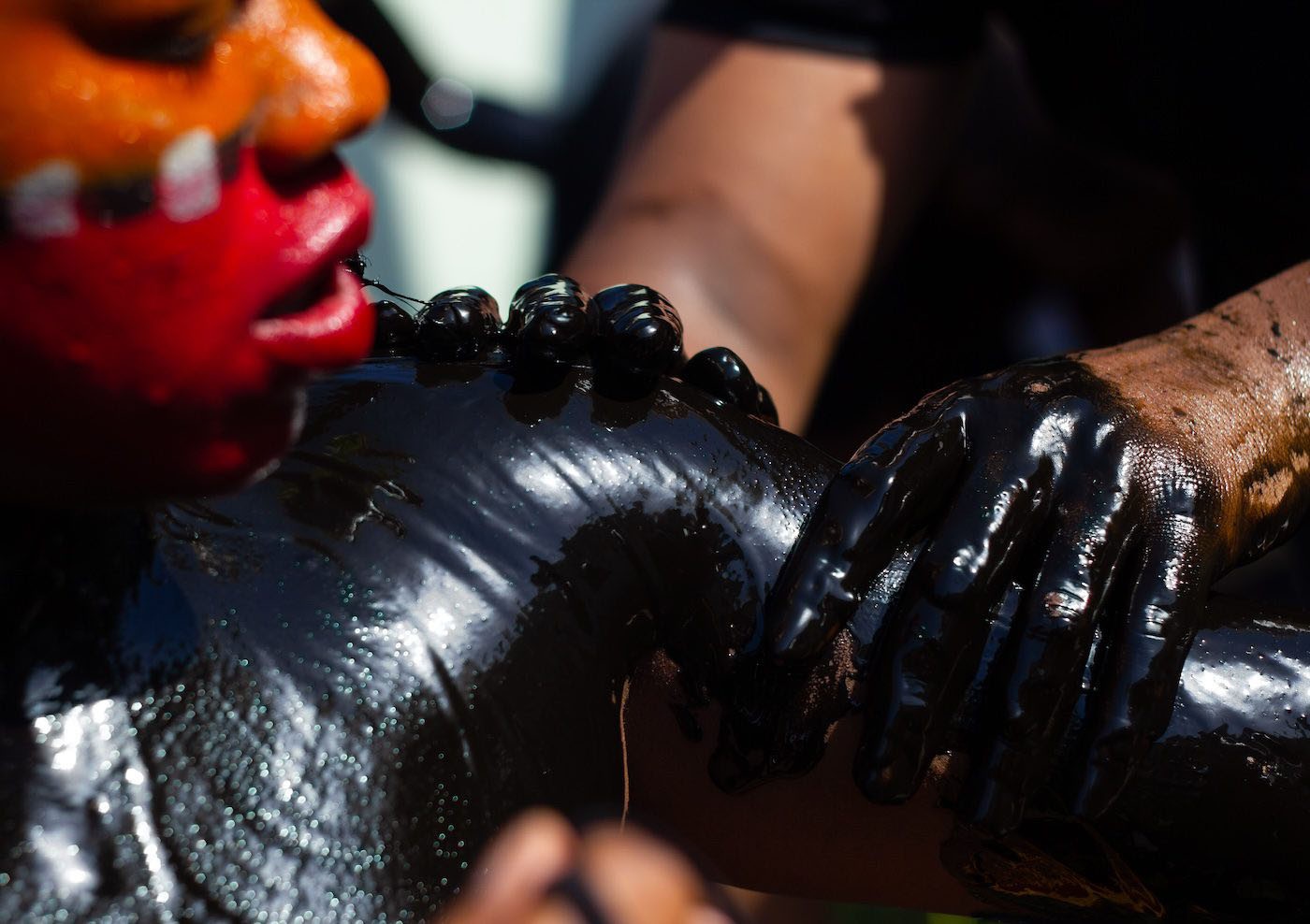El Hadji Sy: "From a restorer’s perspective, when art starts to rot, it loses value. For me this aspect of transformation is essential."

17 February 2015
Magazine C& Magazine
Words Julia Grosse
10 min read
"El Hadji Sy: Painting, Performance, Politics" at the Weltkulturen Museum in Frankfurt is the first retrospective exhibition of the painter and curator El Hadji Sy.
El Hadji Sy: Painting, Performance, Politics is the first retrospective exhibition of the painter and curator El Hadji Sy (born 1954, Dakar), whose interdisciplinary practice represents a conceptual and aesthetic nerve within post-Independence art in Africa.
Exhibited internationally as a painter since the late 1970s, and hailed by the late Senegalese poet and president Léopold Sédar Senghor, El Hadji Sy is equally known for his defiant attitude towards state cultural policy. In his capacity as a cultural activist who has worked and lived in Dakar all of his life, Sy has never ceased to challenge the authorities and fight for his own artistic autonomy and that of his peers. In 1977, he took charge of squatting an army barracks on the seafront of Dakar, which became the first rendition of the Village des Arts, a creative hub for seventy artists, actors, musicians, film-makers and writers. There, in 1980,he founded the multi-disciplinary project space Tenq, a Wolof term that signifies ‘articulation’, and continued to remodel this curatorial dialogue in other locations during the 1980s and 1990s. The international workshops that he organized under the same name in Saint-Louis du Senegal (1994) and Dakar (1996) enabled new networks to be forged between artists working in continental Africa and in Europe at a time when web-centric communications and social media did not yet exist. As an active player in the Laboratoire AGIT’ART since the collective’s foundation in the mid-1970s, Sy was responsible for its visual staging and its costumes, but also for its strategic interpellation of Senegalese cultural politics. He was an originator of the interventionist artists’ group Huit Facettes, whose work in rural Senegal was presented at documenta 11 in Kassel in 2002.
The exhibition, which is co-curated by Philippe Pirotte, director of the Städelschule and Portikus, combines El Hadji Sy’s installations and paintings – sometimes executed with his bare feet or produced on unusual surfaces such as industrial rice sacking or synthetic kite silk – with his selection of ethnographic objects and artworks by colleagues from Senegal. For in 1985 the museum commissioned El Hadji Sy with the task of assembling a new group of works of contemporary art from Senegal, thereby initiating a long-term relationship between Frankfurt and Dakar. The exhibition includes loans from private collections in Senegal, France, and Belgium in addition to works from the collection of the Weltkulturen Museum.
In the mid-1970s, in a pioneering move, the Weltkulturen Museum began collecting contemporary artworks from Africa. Today it has over 3000 paintings, prints and sculptures in its collection.
Julia Grosse: This exhibition brings together several different sized paintings on rice sacking. Here the ‘blank canvas’ is already loaded with industrial processes.
El Hadji Sy: Exactly. I don’t like the idea of a perfect white canvas with a flat surface. For me, the surface has to be like a skin, a physicality that I can work on and that changes.
JG: Like the huge painting of Abdoulaye Wade, the former President of Senegal?
EHS: Yes, I painted his portrait on the paper they use at the butcher’s to wrap up meat. Over time it changes, just like real skin, and I like that. With his huge staring eyes, the president looks horrible and appears to be horrified at the same time. I couldn’t have depicted the intensity of his gaze on normal, white, flat paper.
JG: You restored the painting when it arrived in Frankfurt?
EHS: Yes, when it arrived here it needed fixing. If works are close to me and something happens to them, I can be their doctor! So I fixed it and it looks a little different. But it’s normal for things to change, to look different.
JG: There aren’t many materials that you haven’t worked with. Rice bags, fabrics, wood, aluminium, tar...
EHS: I experiment with all sorts of different materials because I’m not interested in a discourse on materials but on how they change. From a restorer or conservator’s perspective, when works of art start to rot, they lose value. But for me this aspect of transformation is essential.
JG: Senghor is famous for having initiated a tapestry manufactory in Dakar and later at Thiès. How much did it influence you as a young artist?
EHS: In the 1960s and 1970s, many artists made maquettes – designs – to be woven into tapestries, and the Senegalese government bought them. Firstly, I didn’t like this form of exploitation of the artist and their ideas, their creativity. Secondly, I am more of a fresco person. I’ve done works that are sometimes 40m long. You can’t do that with tapestries. I also build large canvases from the bags once used to contain rice, sugar or coffee. They have different a porosity and aren’t treated in the same way as industrial canvas. And unlike murals or mosaics, I can take them off the wall and put them up wherever I want. I like the idea of transforming a classified material and uplifting it into something more precious, more noble.
JG: But when I look at the way you hang some of your paintings on the wall, on wooden bars, it definitely has the style and aesthetic of tapestry...
EHS: Yes, but I mock it! I perform a critique of tapestry.
JG: You play with the aspect of the artwork as a fluid, mobile, performative structure. In the show, we see paintings as movable screens, kites hanging from the ceiling, banners placed outside the museum that move with the wind, and other canvases that lie on the ground like carpets. Is it important for you to literally spread your work across diverse locations, from the museum into the street?
EHS: Yes, it’s never just about one place. That’s why I am not too fond of the limited space of a gallery environment. When I think of exhibiting, I imagine sitting in a truck that contains all my work and driving to a small village and stopping at the marketplace because it is a public space. I start to install my art and people can approach it and enjoy it. That’s my idea of the mobility of art. I always loved the circus for its ability to appear out of nowhere, unfold everything at the marketplace, do something, enchant people, and disappear again. It’s not about one fixed location.
JG: You want to be both inside and outside the museum. Why?
EHS: It wouldn’t be the way I work to just have a show that is inside the museum. There needs to be a connection to the people outside of the institution, who wouldn’t normally enter it.
JG: Like the three painted banners that hang from flagpoles outside the museum for the entirety of the show, replacing the museum’s usual signage?
EHS: Yes. I installed these artworks as banners for everybody who passes by to see. With the wind blowing, they make a subtle sound. If you are in a car, you’ll look at them for two seconds, but the image will not distract you like a hysterical advertisement because the painted banners are not aggressive.
JG: For one installation in the exhibition you’ve worked with ethnographic objects from the museum’s Oceania collection. You placed four stools in a circle on a huge carpet-like artwork. You’ve painted something like a well in the centre and reflections of possible faces looking into the water. It is like a place where truths are exchanged. What intrigued you about these artefacts, what prompted you to take them and mix them with your work?
EHS: Firstly, the Weltkulturen Museum works with a certain philosophy that involves mixing objects. In contrast to Picasso, who might have collected African artefacts and kept them in his studio to work from, I believe I have more freedom and more play. I can displace these objects and establish a new contextual relationship with them, and a formal and philosophical dialogue with the practice of contemporary art. As an artist or an author, I am present, whereas the authors of the other objects are unknown. When the curators at the museum speak about them, they refer to this ancient object, which they are experts on and have written about. They can do this because the object has no author other than the ethnic community to which it is attributed. But when I am there with the object, then the curator is silent. They can no longer speak on behalf of the object because an author is there. So there’s a jump between the historical and contemporary practice.
JG: Do you see these stools from New Guinea as art or as design objects?
EHS: I see them more as design, that is in terms of their initial function. I ask three questions of the object: Is it a found object? Is it a stolen object? Or is it a created object? I belong to the group of people who create objects so I can talk about them. This has nothing to do with those who find objects, or who steal them in order to develop an economy around them.
JG: Theatre plays an important role in your life as an artist. Why?
EHS: I worked a lot in theatre and it taught me to understand detachment between myself and objects, myself and people, myself and roles, and myself and representation. I’m interested in Brecht’s notion of distance.
JG: Why is distance important to you as an artist?
EHS: As a painter, it’s essential that I work with distance. Otherwise I don’t see anything, and become confused within my own work. That sense of fusion can become a problem.
JG: Why?
EHS: Take the stools that I selected from the collection. If these were not museological objects, I would invite the public to sit on them. Yet here you cannot touch them. So how does one deal with the no-touch situation and the initial use of these objects?
JG: In the same painting on which you placed the stools, you use a very dark colour. Is it tar?
EHS: Yes. And do you know what? In Wolof, there is no word for ‘art’. Instead we say ‘tar’ and ‘tar’ means beauty.
JG: What is the role of colour in your work?
EHS: The gaze is colour, and light determines the stroboscopic quality of colour. When I arrived in Frankfurt, I opened up the crates with my works and immediately the paintings spoke of a different light. Each one contains its own sun, its light from the sun. Colour defines ambience, whether psychological or physical. It can appear to be very material, but actually it’s only an effect of light. There are three primary colours: red, yellow and blue. All the rest is kitchen chemistry. . .
This interview is an excerpt from the comprehensive monograph published by diaphanes in English and German. It includes manifestos and newspaper cuttings of the period, together with newly commissioned essays and interviews byHans Belting,Clémentine Deliss, Mamadou Diouf,Julia Grosse,Yvette Mutumba,Philippe Pirotte and Manon Schwich.
El Hadji Sy: Painting, Performance, Politics, 05 MARCH - 18 OCTOBER 2015, Weltkulturen Museum, Frankfurt a. Main, Germany. The exhibition tours to the National Gallery in Prague/ Narodni galerie v Praze and to the Centre for Contemporary Art Warsaw Ujazdowski Castle/Centrum Sztuki Wspo?czesnej Warszawa Zamek Ujazdowski in 2016.
.
Read more from

Naomi Beckwith Unveils Core Artistic Team for documenta 16

Fundação Bienal de São Paulo Announces List of Participants for its 36th Edition

Venice Biennale 2026 Will Follow Late Koyo Kouoh's Vision
Read more from

Jesús Hilário-Reyes: Dissolving Notions of Group and Individual

A Biennial that relates sound to space and bodies

